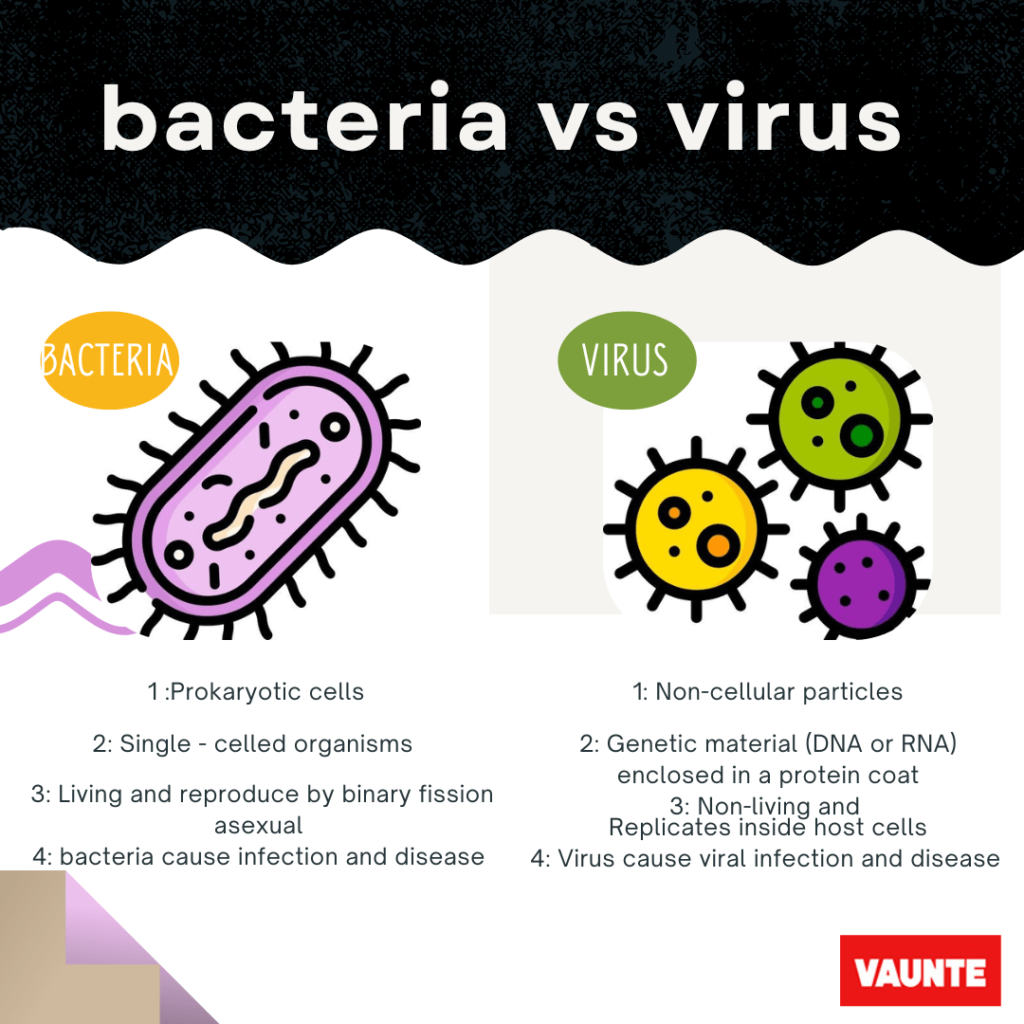Viruses and bacteria are both types of microorganisms that can cause diseases in humans. However, many people wanna know that How are Viruses Different from Bacteria and they are differ in many ways, including their structure, reproduction, and treatment.
Viruses Different from Bacteria Apex
Firstly, viruses are much smaller than bacteria and cannot survive outside of a host organism. They consist of genetic material (DNA or RNA) surrounded by a protein coat, and sometimes a lipid envelope. In contrast, bacteria are single-celled organisms that can survive and reproduce on their own. They have a more complex structure, with a cell wall, cytoplasm, and genetic material in the form of DNA.

Secondly, viruses reproduce by infecting host cells and hijacking their machinery to create more copies of themselves. They do not have the ability to reproduce on their own. Bacteria, on the other hand, can reproduce by dividing in half through a process called binary fission. This means that bacteria can multiply rapidly and form colonies.
Size Comparison:
Bacteria are typically larger than viruses. Most bacteria range from 0.5 to 5 micrometers in size, while viruses are much smaller, ranging from 0.02 to 0.3 micrometers. This size difference is due to the fact that bacteria are single-celled organisms with complex cellular structures, while viruses are much simpler in structure.
Cellular Structure:
Bacteria are prokaryotic cells, meaning they lack a true nucleus and membrane-bound organelles. They have a cell wall that provides structure and protection, and some bacteria also have flagella or pili for movement and attachment. In contrast, viruses are not cells and do not have a cellular structure. They are simply genetic material (either DNA or RNA) surrounded by a protein coat called a capsid.
Reproduction Methods:
Bacteria reproduce by binary fission, a process in which one cell divides into two identical daughter cells. Some bacteria are also capable of transferring genetic material through conjugation, transformation, or transduction. Viruses, on the other hand, cannot reproduce on their own. They must infect a host cell and hijack its machinery to replicate their genetic material and produce new virus particles.
Treatment and Prevention:
Antibiotics are commonly used to treat bacterial infections, but they are not effective against viral infections. Viral infections are typically treated with antiviral drugs, which target specific stages of the viral life cycle. Vaccines are available for some bacterial and viral infections, but they work differently. Bacterial vaccines stimulate the immune system to produce antibodies that can recognize and fight off the bacteria. Viral vaccines contain a weakened or inactivated form of the virus, which triggers an immune response without causing disease.
Understanding Viruses:
Viruses are tiny infectious agents that are much smaller than bacteria. They are generally composed of a protein coat called a capsid, which encloses genetic material, either DNA or RNA. Some viruses also have an outer envelope made of lipids, which helps them to infect host cells.
Virus Reproduction:
Viruses are obligate intracellular parasites, which means that they can only reproduce inside a host cell. To infect a host cell, a virus must first attach to a specific receptor on the surface of the cell. Once inside the cell, the virus uses the host cell’s machinery to replicate its genetic material and produce new virus particles.
There are two main types of viral replication: the lytic cycle and the lysogenic cycle. In the lytic cycle, the virus replicates rapidly, causing the host cell to burst and release new virus particles. In the lysogenic cycle, the virus integrates its genetic material into the host cell’s genome and replicates along with the host cell. The virus can remain in this latent state for a long time before switching to the lytic cycle.
Virus Pathogenicity:
Viruses can cause a wide range of diseases, from the common cold to more serious illnesses such as AIDS, Ebola, and COVID-19. The pathogenicity of a virus depends on a variety of factors, including its ability to infect host cells, evade the host immune system, and cause damage to host tissues.
Some viruses, such as HIV, can persist in the body for years without causing symptoms, while others, such as influenza, cause acute illness that resolves within a few days to a week. Vaccines and antiviral drugs can be effective in preventing or treating viral infections, but the development of new treatments and vaccines is an ongoing challenge due to the rapid evolution of viruses.
Understanding Bacteria
Bacteria are single-celled microorganisms that are found almost everywhere on Earth. They can be found in soil, water, air, and even inside other organisms. Bacteria can have different shapes, such as spherical, rod-shaped, or spiral.
The structure of bacteria is relatively simple. They are prokaryotes, which means that they lack a nucleus and other membrane-bound organelles. Instead, their genetic material is contained in a single circular chromosome that floats freely in the cytoplasm. Bacteria also have a cell wall that provides structural support and protection.
Conclusion:
In conclusion, understanding the differences between viruses and bacteria is crucial for preventing and treating infections. While both can cause harm, they require different approaches for diagnosis, prevention, and treatment.
